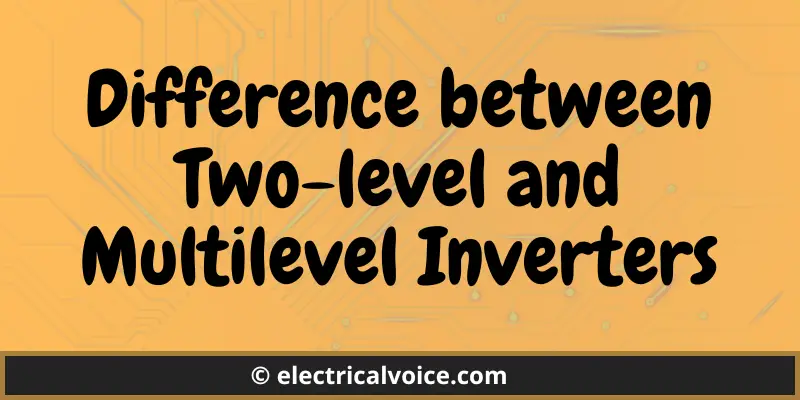Two-level inverters and multilevel inverters are the types of inverters based on the levels in the output voltage waveform. Multilevel inverters offer superior performance compared to two-level inverters with the same power ratings. The basic difference between two-level and multilevel inverters is that a two-level inverter generates two levels in the output voltage waveform whereas a multilevel inverter generates more than two levels in the output voltage waveform.

Difference between Two-level and Multilevel Inverter
In this section, we will see the differences between two-level and multilevel inverters in detail.
Due to the semiconductor’s blockage voltage limitation, conventional two-level inverters cannot operate at medium voltages. On the other hand, multilevel inverters play an important role in medium-voltage and high-power applications.
Multilevel inverters offer advantages over two-level inverters in terms of reducing the harmonic content of line-to-line voltages that are fed to the load.
The structure of a 2-level inverter is complicated whereas a multilevel inverter has a modular structure.
The stress on power electronic switching devices is higher in two-level inverters as compared to multilevel inverters.
Two-level inverter finds use in low-voltage applications whereas multilevel inverters are used in medium-voltage and high-power applications.
A two-level inverter provides low power quality as compared to multilevel inverters.
The harmonic content of output in the case of a two-level inverter is higher as compared to a multilevel inverter.
Electromagnetic interference (EMI) immunity/susceptibility is lower in the case of a two-level inverter as compared to a multilevel inverter.
Electromagnetic interference (EMI) generation is higher in the case of a two-level inverter as compared to a multilevel inverter.
The production of common-mode voltage is higher in the case of a two-level inverter as compared to a multilevel inverter.
A two-level inverter doesn’t have the ability of transformer-less operation whereas a multilevel inverter has the ability of transformer-less operation.
A two-level inverter has lower efficiency as compared to a multilevel inverter.
A two-level inverter has higher switching losses as compared to a multilevel inverter.
A two-level inverter fails to operate at fundamental switching frequency whereas a multilevel inverter can operate at fundamental as well as high switching frequencies.
The input current distortions are higher in the case of a two-level inverter as compared to a multilevel inverter.
The fault-tolerant operation is impossible in the case of a two-level inverter whereas fault-tolerant operation is possible in the case of a multilevel inverter.
The rate of change of voltage (dv/dt) is higher in the case of a two-level inverter as compared to a multilevel inverter.
The production of multiple voltage levels is impossible in the case of a two-level inverter whereas it is possible to produce multiple voltage levels in the case of a multilevel inverter.
The above-mentioned differences are summarized in the following table.
| Two-level Inverter | Multilevel Inverter |
| It generates two levels in the output voltage waveform. | It generates more than two levels in the output voltage waveform. |
| It has a complicated structure. | It has a modular structure. |
| It is used in low-voltage applications | It is used in medium-voltage and high-power applications. |
| There is more voltage stress on power electronic switching devices. | There is lesser voltage stress on power electronic switching devices. |
| It provides low power quality at the output. | It provides high power quality at the output. |
| The harmonic content of the output is higher. | The harmonic content of the output is lower. |
| It has lower electromagnetic interference (EMI) immunity/susceptibility. | It has higher electromagnetic interference (EMI) immunity/susceptibility. |
| Electromagnetic interference (EMI) generation is higher. | Electromagnetic interference (EMI) generation is lower. |
| It produces higher common-mode voltage. | It produces lower common-mode voltage. |
| It doesn’t have the ability of transformer-less operation. | It has the ability of transformer-less operation. |
| It has low efficiency. | It has high efficiency. |
| It has higher switching losses. | It has lower switching losses. |
| It cannot operate at a fundamental switching frequency. | It can operate at fundamental as well as high switching frequencies. |
| The input current distortions are higher. | The input current distortions are lower. |
| The fault-tolerant operation is impossible. | The fault-tolerant operation is possible. |
| The rate of change of voltage (dv/dt) is higher. | The rate of change of voltage (dv/dt) is lower. |
| The production of multiple voltage levels is impossible. | The production of multiple voltage levels is possible. |
There are many advantages and disadvantages of multilevel inverters in comparison to two-level inverters. I hope this article helps you in getting an understanding of two-level and multilevel inverters.
